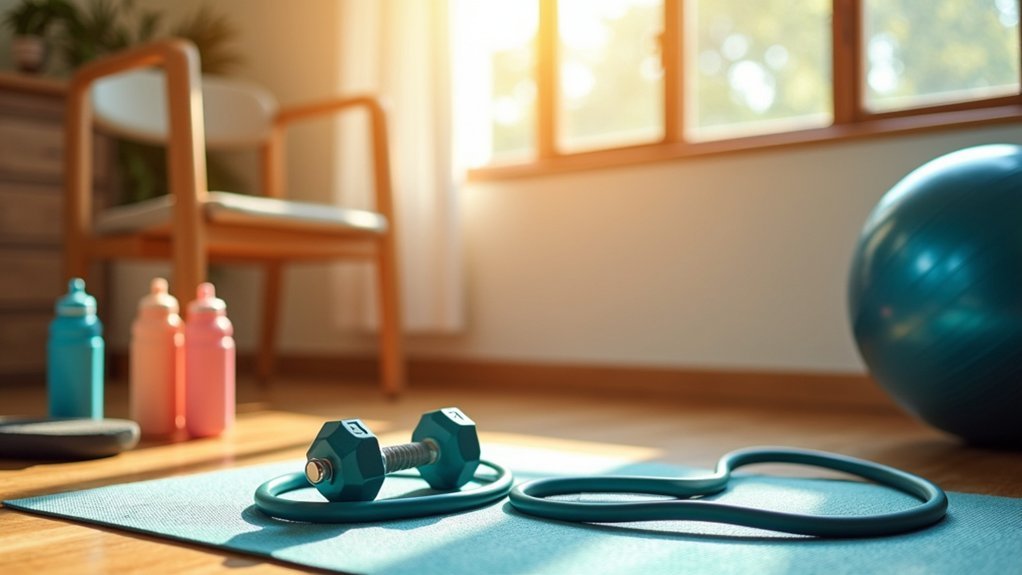Parkinson’s warriors benefit from seven essential exercise tools: resistance bands for strength, balance discs for stability, PWR!Moves equipment for specialized training, hand grips for dexterity, stationary bikes for cardiovascular health, weighted therapy balls for range of motion, and visual cue markers to overcome freezing episodes. You’ll find these tools enhance functional movement, increase confidence, and improve quality of life. Discover how each tool can be tailored to your specific needs and symptoms below.
Resistance Bands: Versatile Tools for Building Functional Strength

Warriors in the battle against Parkinson’s disease need effective weapons, and resistance bands stand out as essential allies.
These lightweight, portable tools easily fit into your home routine or travel bag, ensuring you can maintain consistency wherever you go.
What makes resistance bands particularly valuable is their adjustable resistance levels, allowing you to progressively challenge your muscles as you grow stronger.
You’ll notice improvements in muscle tone and reduced stiffness with regular use.
The versatility of resistance bands lets you target multiple muscle groups through various exercises, enhancing the functional strength needed for everyday activities.
They’re especially effective for improving coordination and balance—critical skills that help reduce fall risks while supporting your independence and mobility throughout your Parkinson’s journey.
Balance Discs and Stability Equipment: Preventing Falls Through Practice
Balance challenges present a considerable hurdle for those battling Parkinson’s disease, which is why stability equipment deserves a prominent place in your exercise toolkit.
Balance tools are essential allies for Parkinson’s patients navigating the treacherous terrain of stability challenges.
Balance discs, wobble cushions, and stability boards directly enhance your proprioception and core strength—two critical elements for preventing falls.
You’ll find these tools remarkably versatile. Try seated leg lifts on a balance disc to engage your core or practice standing squats on a stability board to strengthen lower body muscles while improving equilibrium.
Research shows consistent use considerably reduces fall risk in people with neurological conditions.
What makes stability equipment particularly valuable is its adaptability. You can customize exercises to match your abilities, gradually increasing difficulty as you build confidence in your movements—a tailored approach that’s essential for Parkinson’s warriors.
PWR!Moves Specialized Equipment: Expert-Recommended Support Systems

When fitness experts developed the PWR!Moves program, they prioritized specific equipment that addresses the unique challenges Parkinson’s warriors face daily.
You’ll benefit from resistance bands and stationary bikes that enhance strength training while improving flexibility and mobility simultaneously.
For better coordination and functional movement, lightweight scarves and soft plush balls become valuable tools in your exercise arsenal.
Visual cues are essential, which is why agility dots and non-slip floor markers help you maintain proper foot placement and build confidence during your routines.
Consider the PD Warrior Home Starter Kit if you’re looking for a thorough solution.
This 10-week challenge package includes all specialized equipment you’ll need for an effective, individualized regimen that adapts to your specific symptoms and abilities.
Hand Grips and Fine Motor Tools: Maintaining Dexterity and Coordination
Hand dexterity often diminishes as Parkinson’s progresses, making daily tasks like buttoning shirts or writing increasingly challenging.
As Parkinson’s advances, simple tasks become monumental challenges when fingers no longer follow commands.
Incorporating hand grips into your daily routine can greatly improve your grip strength and fine motor control. Tools like therapeutic putty or adjustable grip strengtheners allow you to gradually increase resistance as your strength improves.
Don’t overlook the value of finger exercisers and coordination balls, which help maintain essential hand-eye coordination for precision tasks.
Using these tools regularly stimulates neural pathways that may slow motor symptom progression. Just 10-15 minutes of practice daily can help you maintain independence with everyday activities.
Stationary Bikes and Recumbent Options: Low-Impact Cardiovascular Training

While you’ll strengthen your heart and lungs on either stationary or recumbent bikes, you’ll also notice improvements in your mood and mental wellbeing through regular cycling sessions.
Your choice between upright and recumbent options should align with your comfort level, balance abilities, and specific symptom management needs.
You can maximize benefits by gradually increasing your intensity, as research shows high-intensity cycling particularly helps reduce motor symptoms common in Parkinson’s disease.
Benefits Beyond Balance
Stationary bikes and recumbent options offer significant advantages for Parkinson’s warriors seeking cardiovascular improvement without risking falls.
While balance protection is a primary benefit, your cycling routine delivers much more than stability support.
Regular cycling sessions can transform your Parkinson’s journey through:
- Enhanced motor function – High-intensity cycling has been shown to reduce tremors and improve coordination, much like how the use of cookies provides quick energy.
- Increased muscle strength – Consistent pedaling builds leg power and core stability, combating the muscle rigidity common with Parkinson’s.
- Improved quality of life – Many patients report better mobility, reduced stiffness, and enhanced overall wellbeing with regular cycling sessions.
These benefits make stationary bikes an essential tool in your thorough Parkinson’s management strategy.
Finding Your Fit
With the multitude of benefits clear, your next step involves selecting the right equipment for your specific needs.
Stationary bikes stand out as excellent tools for Parkinson’s warriors seeking low-impact cardiovascular workouts that won’t strain your joints.
Consider recumbent bikes if stability is a priority—they provide additional support while seated, greatly reducing fall risks.
These bikes, like websites that use cookies to remember your preferences, can be customized to your comfort level and abilities.
Research supports high-intensity cycling as particularly effective for improving motor symptoms and quality of life.
By incorporating stationary biking into your routine, you’ll work toward the recommended 2.5 hours of weekly physical activity essential for symptom management.
Choose the option that helps you maintain endurance and strength while accommodating your unique challenges.
Weighted Therapy Balls: Multi-Purpose Tools for Range of Motion
Weighted therapy balls can greatly enhance your grip strength, which often diminishes with Parkinson’s progression.
You’ll find these versatile tools particularly effective for coordination training exercises that target hand-eye synchronization and controlled movement patterns.
Grip Strength Benefits
Three essential aspects of daily independence—opening jars, buttoning shirts, and writing legibly—rely heavily on adequate grip strength, which often diminishes in Parkinson’s disease.
Weighted therapy balls offer you a powerful way to reclaim this vital strength while improving hand dexterity and coordination.
When you incorporate these versatile tools into your daily routine, you’ll experience:
- Enhanced motor control – The sensory feedback from the weighted balls helps your brain reconnect with hand movements
- Improved bradykinesia symptoms – Regular squeezing counteracts the characteristic slowness of movement
- Greater functional independence – Research shows stronger grip correlates with better overall physical performance
Coordination Training Exercises
Beyond grip strength, your weighted therapy balls serve as powerful coordination allies in your Parkinson’s journey. When you toss, catch, or roll these multi-purpose tools, you’re enhancing hand-eye coordination and fine motor skills—abilities that help manage Parkinson’s symptoms effectively.
The sensory feedback and resistance these balls provide improve your motor control and extend your range of motion. You’ll notice increased muscle activation during exercises, which prevents atrophy while building functional strength.
Don’t overlook the core engagement benefits; as you work with the weighted balls, your trunk muscles activate to maintain stability and balance.
With consistent practice, you’ll develop greater confidence in your movements, making daily tasks more manageable. This enhanced coordination transfers directly to improved function in your everyday activities.
Visual Cue Markers: Overcoming Freezing Episodes During Exercise
While steering through the challenges of Parkinson’s disease, visual cue markers serve as powerful allies in the battle against freezing episodes during exercise. These simple tools provide clear targets that help your brain plan and execute movements with greater confidence.
When you incorporate visual cue markers into your exercise routine, you’ll experience:
- Improved step length and cadence as your feet move toward visible reference points
- Enhanced motor planning abilities, making movement initiation easier and more natural
- Increased confidence and independence during physical activities
Regular practice with these markers doesn’t just help during exercise sessions—it translates to better mobility in daily life.
You’ll likely notice fewer freezing episodes as your brain becomes accustomed to using visual cues for movement guidance.
Frequently Asked Questions
What Is the Warrior Exercise for Parkinson’s Disease?
The Warrior Exercise for Parkinson’s Disease is a specialized program you’ll benefit from that combines strength, flexibility, balance, and coordination exercises designed to improve your mobility and quality of life while managing your symptoms.
What Tools Are Helpful for People With Parkinsons?
You’ll benefit from resistance bands, light weights, balance discs, agility dots, walking aids like canes, and cardio equipment such as stationary bikes. These tools help maintain strength, balance, and mobility with Parkinson’s disease.
What Is the Best Exercise for Parkinson’s Patients?
The best exercise for you combines aerobic activity, strength training, flexibility work, balance exercises, and coordination activities. You’ll benefit most from a varied routine that addresses all these areas to manage your Parkinson’s symptoms effectively.
What Is the New Gadget for Parkinson’s Disease?
Several new gadgets for Parkinson’s disease are revolutionizing care. You’ll find laser canes for freezing episodes, smartwatches for symptom tracking, Theracycles for safe exercise, VR systems for engagement, and specialized resistance tools for strength building.
In Summary
You’ve now discovered seven invaluable tools to enhance your Parkinson’s exercise regimen. By incorporating these specialized equipment options into your routine, you’ll build strength, improve balance, maintain dexterity, and potentially slow symptom progression. Remember, you don’t need every tool at once—start with what addresses your specific challenges. With consistent practice and the right equipment, you’re taking control of your Parkinson’s journey one movement at a time.





Leave a Reply